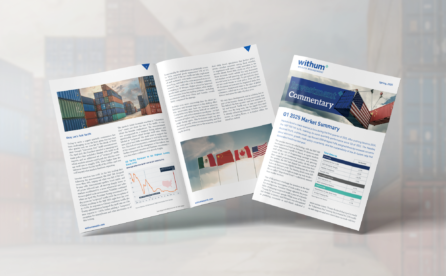With Donald Trump’s recent victory in the presidential election, financial markets are poised for potential shifts across various sectors. Historically, markets tend to stabilize when political outcomes are clear, and now that the election is settled, initial uncertainty has eased. However, as we assess the implications of a Trump presidency, investors are watching closely for policy changes that could affect different asset classes.
Tax Cuts, Deregulation and Trade Policies
One of the most prominent features of Trump’s platform is a renewed focus on tax cuts and deregulation, which could prove favorable for equities. Sectors such as consumer discretionary, communication services, and financials may see a boost as lower corporate taxes could translate to higher profitability and more cash flow for companies. Additionally, if regulatory relief is enacted, banks and other financial institutions could face fewer compliance costs, potentially enhancing their bottom lines. On the other hand, proposed tariff measures could raise costs for companies dependent on imports, potentially impacting consumer prices and spending. The trade policies that Trump has hinted at may lead to higher production costs for some industries, which could trickle down to consumers and, in turn, affect spending behavior.
Energy is one sector that may see immediate positive momentum as the market anticipates a friendlier regulatory environment. This was also the case after Trump’s initial election in 2016 when energy stocks rallied through year-end. However, as we saw during Trump’s first term, initial gains in sectors like energy may not guarantee strong performance over a more extended period. Crosswinds, including global oil prices and longer-term market shifts, played a role in the sector’s mixed performance. While we may see an initial jump in energy and other deregulation-sensitive industries, assessing how broader economic and policy dynamics could impact these sectors over time is crucial.
The defense and infrastructure sectors may experience strong support under Trump’s administration. The defense industry could see a renewed focus on military spending and modernization, as Trump has historically prioritized these areas. Meanwhile, infrastructure investment could also gain attention, given Trump’s prior emphasis on the need for substantial upgrades to U.S. infrastructure. Increased spending in these sectors could drive demand in construction, materials, and defense industries, creating potential growth opportunities as these initiatives develop.
Inflation and Fixed Income Market Dynamics
The inflation outlook will likely remain a central focus as well. While inflation rates have slowed to around 2%, bringing them close to the Fed’s target rate, prices remain about 20% higher than pre-pandemic levels—a reality that impacts consumers across the income spectrum. For many Americans, elevated prices serve as a constant reminder of underlying economic imbalances, even amid broader economic health. Trump has pledged to tackle inflation; however, some of his proposed policies, like additional tariffs on imports from China, could contribute to rising prices for goods such as clothing and appliances. Additionally, proposed deportation policies may create labor shortages in sectors like construction and agriculture, potentially driving costs higher. Combined with planned tax cuts that could increase the national debt, these policies could add pressure to inflation over time, making it a complex issue for the administration to navigate.
In the fixed-income arena, a Trump administration could mean increased fiscal stimulus combined with tax reductions, likely resulting in a higher level of government borrowing. This increased debt issuance could push bond yields upward, leading to a potential price decline. Investors in the bond market may need to adjust expectations for future rate movements, as rising yields often signify tighter conditions for borrowers and can impact investment-grade and high-yield bonds differently. For our clients with fixed-income exposure, we’ll be making sure portfolios are positioned to manage any potential rate impacts effectively.
Tax and Currency Implications
On the tax front, individual and estate taxes may see significant shifts under a Trump administration. The Tax Cuts and Jobs Act (TCJA) of 2017 introduced substantial tax reductions, including a significant increase in the estate tax exemption. However, many of these provisions are set to expire at the end of 2025, which would reduce the estate tax exemption from approximately $13.61 million per individual to about $7 million, adjusted for inflation. Trump has expressed intentions to make these tax cuts permanent, which would maintain the higher exemption levels beyond 2025. Such changes could have profound effects on tax and estate planning strategies, and we’ll be closely monitoring these potential developments to keep clients’ plans optimized in light of any new tax legislation. (See recent episode of our Amplified Wealth Podcast: Election Year Tax Insights – What Lies Ahead for 2025 and Beyond).
Currency markets are another area that could see notable shifts under Trump’s leadership. Protectionist trade policies and a stronger stance on tariffs could lead to a firmer U.S. dollar, as global investors may seek stability in the U.S. currency amid potential trade realignments. While a stronger dollar can benefit importers and consumers, it may pose challenges for multinational corporations that derive substantial revenue from overseas markets as their goods and services become more expensive for foreign buyers.
Approaches for Investors Amid Political Change
Digital assets like cryptocurrencies may be poised for a more favorable regulatory environment. Over the past year, Trump and the Republican party have shifted to embrace digital assets, seeing them as an opportunity to foster innovation and strengthen the financial sector. A more supportive stance could lead to new frameworks that clarify the role of cryptocurrencies and blockchain in the economy, potentially boosting investor confidence and spurring growth in the sector. We’ll monitor any regulatory changes closely to help clients understand their impact on digital assets.
As we navigate these potential changes, there are several prudent approaches for investors to consider. First, maintaining a diversified portfolio remains essential. With market reactions potentially varying by sector, a well-diversified allocation can help to mitigate the impact of sector-specific risks. Additionally, we’ll be closely assessing risk exposure, especially in industries sensitive to regulatory changes, such as technology and energy – working to keep client portfolios aligned with their unique risk profiles.
Trump’s policies may indeed present both opportunities and challenges for different areas of the market. While some sectors might benefit from deregulation and tax cuts, others may face headwinds from protectionist measures. As we move forward, a proactive approach to portfolio management will help investors navigate these developments while staying aligned with their financial goals. As always, we’ll continue monitoring developments closely and adjusting strategies as needed to help keep our clients on track as the market landscape evolves.


